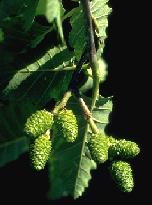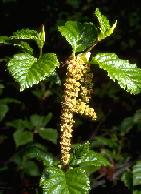

Mountain Alder
Alnus tenuifolia
Nutt.
The Mountain Alder is a shrub or small tree up to 20 feet
tall of forest streams and has an
extensive root system. This usually shrubby alder is distinguished by its
doubly toothed and sometimes lobed leaves that are rounded or heart-shaped
at the base. It
has 2 or more main stems with and smooth grey bark. The leaf edges are sharp
pointed, with rather long teeth and appear wrinkled. Leaves are alternate, simple, ovate to oblong, up to 4 inches long,
pointed or rounded at the tip, rounded or heart-shaped at the base, doubly
toothed and sometimes shallowly lobed, paler on the lower surface, with
hairy veins. It flowers in April through June. Male and female flowers borne separately but on the same
plant; male spikes slender, drooping, up to 3 inches long; female spikes
upright, up to 1/2 inch long; flowers open before the leaves unfold. The winter buds stalked and
rounded and the seeds are borne in small dark brown woody cone like structures. Nutlets up to 1/8 inch wide, with a narrow, membranaceous
wing, are borne in a woody "cone." Occurring mainly in the Douglas Fir zones,
it sometimes grows
along streams or mountain meadows in the higher elevations of the sagebrush/grass zone. This is the
most common Alder in Idaho.
Medical Uses: The bark is astringent, emetic, haemostatic, stomachic and
tonic. The bark also contains salicin[226], which probably decomposes into
salicylic acid (closely related to aspirin) in the human body. This is used as
an anodyne. The outer bark is astringent and is applied as a poultice to
bleeding wounds, it also reduces swellings.
Planting: Cuttings of mature wood should be taken
as soon as the leaves fall in autumn, outdoors in sandy soil. Prefers a heavy
soil and a damp situation, but rows well in heavy clay soils; however, it
tolerates very infertile sites. Alder has a fast rate of growth, but
is a short lived tree, which quickly provides sheltered conditions to allow more
permanent woodland trees to become established. In addition, bacteria on the
roots fix atmospheric nitrogen - whilst this enables the tree to grow well in
quite poor soils it also makes some of this nitrogen available to other plants
nearby. Alder trees also have a heavy leaf canopy and when the leaves fall in
the autumn they help to build up the humus content of the soil.
